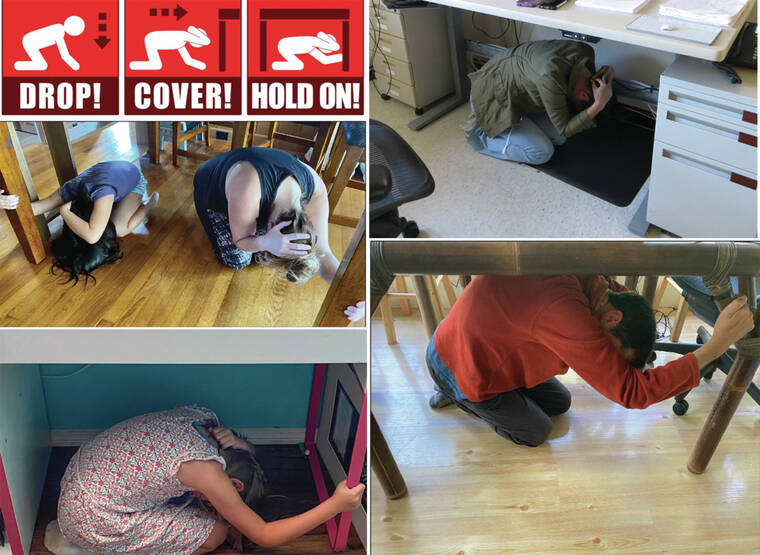Volcano Watch: Earthquakes and volcanoes, a recipe for preparedness
Feeling occasional earthquakes is part of the experience of living in the State of Hawaii, especially on the Island of Hawaii. The vast majority of felt earthquakes are small, but the less common large earthquakes can be damaging, so it is important to be prepared.
The U.S. Geological Survey Hawaiian Volcano Observatory (HVO) records tens of thousands of earthquakes beneath our islands every year. Luckily, most of these are less than magnitude-2, and are not felt. Over the past 30 years, Hawaii has had four earthquakes of magnitude-6 or larger. Three of them were deep (greater than 12 miles or 20 kilometers) and likely the result of the stresses brought forth by the Hawaiian Islands sitting on top of the Pacific plate. The most recent example was the magnitude-6.2 earthquake that struck 17 mile south of Na‘alehu, a few minutes before midnight on Oct. 10, 2021.
The other one was a magnitude-6.9 on May 4, 2018, which is the largest earthquake recorded in Hawaii in the past 30 years. This event was much shallower (less than 9 miles or 15 kilometers) and was likely related to magma moving through the Kilauea plumbing system at the start of the 2018 lower East Rift Zone eruption.
It is a bit of a chicken or egg problem, whether these large, shallow earthquakes under volcanoes lead to eruptions, or if it is the magma shifting stresses along faults that trigger earthquakes. These are two end-member hypotheses, and in reality, it is most likely a combination of both. Earthquakes and volcanic eruptions go hand-in-hand.
We see this kind of interplay between magma movement and seismicity with the ongoing swarm of earthquakes under Mauna Loa summit caldera (Moku’aweoweo) and the upper northwest flank. This elevated seismic activity is accompanied by slight ground inflation (or swelling), which suggests that the Mauna Loa magma reservoir is filling.
Does this mean that Mauna Loa will erupt soon? Not necessarily.
Mauna Loa has been in a period of prolonged unrest. The sleeping giant may just be snoring a little louder than it did a few years ago, but it does not necessarily mean that it will wake up soon.
Scientists at HVO look at many different monitoring streams to document changes in Mauna Loa’s behavior. Some of these changes may alert scientists when an eruption is more likely. Large shallow earthquakes are one of the indicators that move the probability of an eruption of Mauna Loa from “not necessarily” to “highly likely”. For example, a magnitude-6.7 earthquake happened a few months before the last eruption of Mauna Loa in 1984. The 1950 eruption was also preceded by a large earthquake, but only two days prior to the onset of the eruption.
However, not all Mauna Loa eruptions are preceded by large earthquakes. And some large earthquakes, such as the 1975 magnitude-7.7 Kalapana earthquake was not accompanied by a major eruption of Kilauea volcano.
Large shallow earthquakes are not just a potential precursor to volcanic eruptions, but can be a disaster on their own. Damage done by large earthquakes can be mitigated to reduce the hazards and risks associated with violent shaking. Modern building codes make houses much more resistant to damage. Efforts like securing tall heavy objects to the wall so they are less likely to tip over and fall will reduce the likelihood of damage and injury when a large earthquake hits. Earthquake safety drills for “Drop. Cover. Hold On.” should be practiced regularly so that instinct kicks in when the initial shaking is felt.
Join us, and the rest of the world, on Thursday, October 20 (10/20) at 10:20 a.m. local time for the Great Hawaii ShakeOut.
Visit shakeout.org to sign-up and learn more about ways to prepare for large damaging earthquakes.
Volcano Activity Updates
Kilauea volcano is erupting. Its USGS Volcano Alert level is at WATCH. Kilauea updates are issued daily.
Over the past week, lava has continued to erupt from the western vent within Halemaumau crater in Hawaii Volcanoes National Park. Sulfur dioxide emission rates remain elevated and were last measured at approximately 1,800 tonnes per day (t/d) on Sept. 30. Seismicity is elevated but stable, with few earthquakes and ongoing volcanic tremor. Over the past week, summit tiltmeters recorded slow inflation. For more information on the current eruption of Kilauea, see https://www.usgs.gov/volcanoes/kilauea/recent-eruption.
Mauna Loa is not erupting and remains at Volcano Alert Level ADVISORY. This alert level does not mean that an eruption is imminent or that progression to an eruption from the current level of unrest is certain. Mauna Loa updates are issued daily.
This past week, about 320 small-magnitude earthquakes were recorded below the summit and upper elevation flanks of Mauna Loa — the majority of these occurred at shallow depths less than 9 miles below sea level. GPS measurements show continued ground deformation consistent with inflation of a magma chamber beneath the summit. Gas concentrations and fumarole temperatures at both the summit and at Sulphur Cone on the Southwest Rift Zone have remained stable over the past week. Webcams show no changes to the landscape. For more information on current monitoring of Mauna Loa, see: https://www.usgs.gov/volcanoes/mauna-loa/monitoring.
There were no earthquakes reported felt in the Hawaiian Islands during the week ending Thursday.
Visit https://www.usgs.gov/observatories/hawaiian-volcano-observatory for past Volcano Watch articles, updates, photos, maps, recent earthquake info, and more. Email questions to askHVO@usgs.gov.
Volcano Watch is a weekly article and activity update written by U.S. Geological Survey Hawaiian Volcano Observatory scientists and affiliates. Today’s article is by HVO geophysicist Jefferson Chang.


